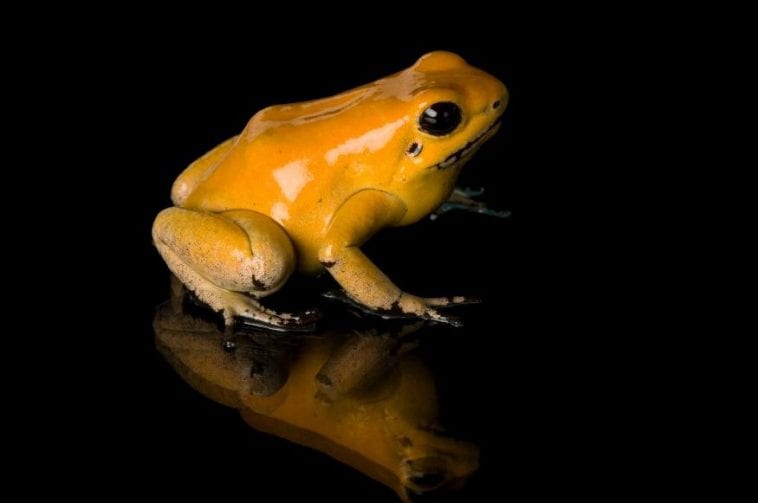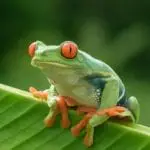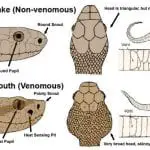The Phyllobates terribilis or golden poison frog is also called with the following names: golden frog, golden dart frog, and golden poison arrow frog. It has four long and slender legs, which four unwebbed toes. Its toes have toe tips which are tiny disks. Males have larger tips than females. it has a bony tooth-like plate found in the upper jaw. The juveniles are black, having stripes in gold on their backside and underbody.
This frog is endemic to Colombia’s Pacific coast area. Their optimal habitat is the rainforest having high rain rates while the altitude is between 100 and 200 m. The temperatures are of at least 26 °C, and relative humidity having 80–90%. In the wild, this frog is a social animal that lives in groups having six individuals; however, in captivity, they can live in much larger groups. These frogs are innocuous because of their small size and bright colors.
If this frog could just talk, perhaps it would say, “don’t eat me.” In the rainforest, they are the jewels that come in various color combinations like red and black, silver and orange, green and yellow, yellow and blue, black and green and silver and pink. These colors serve as a warning to predators who want to eat it. This frog is tiny, diurnal and terrestrial. It lives mainly in leaf litter while others live in the high canopy of the forest and don’t come down. It also lives near the ponds or streams. Its poison is found in its skin that no one should touch it.
Although its toxin is not deadly, it doesn’t taste well for its predators, and it can still be fatal. The poison causes paralysis of the muscle, nausea as well as swelling. A predator that eats a poison frog will leave an impression of never eating the same frog again. Therefore, its whole population takes advantage of this toxin. On the other hand, a type of snake has developed its immunity to this frog’s poison and still eats small poison frogs.
Quick Facts
- Other Name(s): Golden Frog, Golden dart frog, Golden poison arrow frog
- Scientific name: Phyllobates terribilis
- Type of Animal: Amphibian
- Animal Family: Dendrobatidae
- Where is it found: Pacific coast of Colombia
- Average Life span: 10 years
- Length: 1 to 2 inches or 2.5 to 5 centimeters
- Weight: Less than 1 ounce or 28 grams
- Conservation Status: Endangered
Interesting Facts
- Poison dart frogs are not venomous.
- Only 3 frogs are lethal to humans. Golden poison frog is one of them. It is one of the deadliest.
- The poison from this frog is 20 times more toxic than the poison dart frogs.
- If the poison is compared to 2-3 grains of table salt, it can kill humans.
- It can kill about 10 people or 20, 000 mice.
- It could be the most poisonous animal.
- Touching it is just so dangerous.
- This frog’s only natural predator is the Leimadophis Epinephelus. It has developed resistance to this frog’s deadly poison.
The Poison Frog

Video URL: washingtonpost.com
Poison frogs are given the name dart frogs by the people in Western Colombia. They use the poison in order to coat the blow dart’s tip, which they hunt. To avoid the poison, the people make use of a waxy leaf to pick the frog up then; they dip the blow darts into the secretion coming out of the frog’s skin.
Here are the good-to-know facts about poison frogs:
- This frog is not venomous, but poisonous instead. When we say venomous, these are animals that deliver toxin through their spines or fangs, while poisonous animals or plants don’t have a delivery method but a toxin transference by, however, not limited to ingesting. This frog doesn’t use its poison to kill prey but for self-defense rather.
- Its skin is coated densely in alkaloid toxin. This poison stops the nerve of the victim to transmit impulses resulting in inactive muscle contraction that will eventually cause heart failure. This toxin could be stored for years after it is deprived of food. In addition, it does not deteriorate even when it is transferred.
- The average dose this frog carries varies depending on the location and local diet as well, but on average, it is about a milligram of poison. It is like killing 2 African bull elephants. It is like 15,000 humans for every gram. This lethal poison is so rare.
- The toxin batrachotoxin is found in 3 frogs only. The animals only immuned to this poison are these frogs. This toxin attacks the sodium channels in the nerve cells, but these frogs possess special channels of sodium that the poison cannot cause any harm. Captive poison frogs don’t produce this toxin because purchased foods don’t contain alkaloids that produce batrachotoxins, making them lose their toxicity.
- A tiny drop can kill birds and other small mammals that these people hunt. Just one single golden frog that is smaller than a cap is enough to supply 30 to 50 darts. The poison keeps active for a year. That is amazing. According to research, this toxin has 200 times more potency than morphine.
Each species from this frog has various kinds of toxin that is made up of a variety of alkaloids as well as other chemicals. Scientists are doing investigations regarding the use of poison frogs to cure heart and circulatory problems.
In fact, a laboratory came up with a painkiller form the poison frog Epipedrobates tricolor. It was named epibatidine after the frog. Again, this drug is 200 times stronger than morphine without bringing side effects. The efficacy of human use is altered to lessen the potency. The poisonous secretions are also seen as the potential to develop heart stimulants and muscle relaxants.
Habitat and Diet
If you wonder where the toxins come from, it is mainly from its diet that comes from the rainforest. Its diet consists of tiny beetles, centipedes, termites, and ants. To have a diverse diet is necessary for chemical toxins. The toxins from the bugs eaten are collected in the glands found in the frog’s skin. If this frog is raised in the zoo, then it will not have a poison because they eat a regular diet given by the zoo.
Life

Most frogs are active at night, but not with poison frogs. In the daytime, they are avoided due to their color, and poison frog takes advantage of it to look for food too. Poison frogs are in pairs or small groups either. The males fight over territories by wrestling, while the females’ tussle for best sites to lay an egg. In courting, a pair nudges and caresses each other using their forearms and shins.
Breeding starts with these frogs wrestling each other and flipping the rival. The winner takes a mate or a territory. The females become so competitive. Then courtship starts with a male calling a female. It takes an hour.
On average, the female lay clutches having 1 to 30 eggs. The eggs are laid in a moist, dark, and quiet environment like a leaf, a tree branch, or a hole in the trunk. Both the male and female keep moist for the egg and protect them from the growth of fungi and predators like ants.
Both parents are responsible for caring for their eggs. Some species guard the eggs until hatching. This is the male’s duty. The females go back to their tadpoles to feed them with the unfertilized eggs in her body. She then lays them. Others eat their fellow tadpoles, so the mother has to find a different place for each hatchling.
The froglets have a different appearance from their parents. Their body shape, lifestyle, and diet changes. At this stage, they don’t have the toxins in their skin yet, making them vulnerable in the eyes of their predators. As they mature, they will have a different mouth, rear legs, and lungs. They become mature after a year and live for 8 to 15 years, but this depends on each species.
Conservation
Due to the destruction of rainforest caused by fired for farmlands, this frog’s population has been decreasing. In addition, they are also illegally traded. The chytrid fungus is another contributory reason for the devastating effect of frogs as well as other amphibians.
Then, choose your pet wisely. Have in-depth research about the animal before you take it home. Exotic ones may not be a great pet for you and your family. It needs special care and caution. Share this story to spread out awareness. Help organizations by donating your goods, time, and money. This would be for the caring and protection of these animals.
Conclusion
In the wild, predators are anywhere and everywhere, waiting for their prey. A very unlucky and defenseless animal would be an easy target and meal for a predator. Therefore, to survive, Golden poison frogs are lucky enough to have toxins in their bodies to protect them from threats. They may look pleasing in the eye, but they are deadly.



